Reserve Bank of Australia Annual Report – 2014 Management of the Reserve Bank
Financial Costs
Further progress was made on the program of major work that began in 2012/13. Some new services were delivered in banking and settlements and a number of other large projects moved to a more mature stage of development. This extensive program is based on responding to the material influences likely to shape the Reserve Bank's activities in the foreseeable future: changing policy-related operating demands; strategic risks that will become more threatening if left unattended; and the objective of providing better, more efficient and more resilient services to customers and users of the Bank's systems, many of which are critical to sustaining a stable and efficient financial system. Contemporary information and communication technologies are at the core of much, but not all, of this program. The Next Generation Banknote project, the largest of these initiatives, has comparatively little dependence on IT; the purpose of this project is to ensure confidence in Australia's banknotes is maintained.
While some of the program of work will produce assets that will earn significant revenue streams, much of it is justified in terms of the public interest. Without this work, key parts of Australia's financial infrastructure that the Reserve Bank is responsible for maintaining would fall behind good practice and accepted international norms or would not support evolving policy objectives, particularly in the payments area. Systemic risk would rise or be inadequately managed. Important parts of the program complement industry initiatives that have the objective of providing infrastructure to deliver improved services to the public.
The work ranges across most of the Reserve Bank's core activities, including in the financial markets, banking, note issue, payments and settlements and policy areas. In payments and settlements, infrastructure is being developed to allow low-value payments between banks to be cleared and settled in ‘real time’. The Bank is establishing a central ‘hub’ to clear and settle these payments, as well as a payments platform for consumers and businesses to use for their everyday transactions. The core platform for the real-time interbank payments system, RITS (Reserve Bank Information and Transfer System), has been renewed and will provide the foundation for these new services. The Bank will also adapt its own banking services to participate in these system-wide initiatives. At the same time, the major project to introduce new banking systems for the Bank's own customers, the largest of which is the Australian Government, is being progressively implemented.
In financial markets, a platform is being developed to value residential mortgage-backed securities efficiently, and assess and manage the risk of the Reserve Bank holding these instruments. This will support the Bank's market operations in these assets, including for same-day settlement of direct entry payments, and reduce costs for counterparties. This platform will also support the introduction in January 2015 of the Committed Liquidity Facility, which will be available to provide liquidity to banks at times of financial stress. A strategy on managing business information is being implemented, mainly in policy areas, to provide secure and efficient systems to assist the analysis of economic and market information, the basis for the Bank's consideration of policy action. This strategy will result in a significantly lower-cost system than if individual information systems were replaced in a more fragmentary way as they need to be upgraded.
Introducing the new generation of banknotes, while a major strategic initiative in its own right, will also require highly secure storage facilities on a scale that is not currently available. Such a facility has been approved by the Parliamentary Public Works Committee. This facility, to be built on the Reserve Bank's site at Craigieburn, Victoria, will also provide an opportunity to modernise the logistics of storage, distribution and destruction of banknotes, bringing this into line with current international practice. Design of the facility is under way and construction is expected to begin early in 2015.
These individual projects are complex and the portfolio of work would carry material risk for the Reserve Bank if a major component failed. Accordingly, while the costs of this work are heavily concentrated in developing new assets, new resources have also been made available in areas of risk management, compliance and project governance to ensure that the initiatives proceed efficiently and with careful control of risk. In the long term, strong governance is expected to lower the cost of this portfolio by encouraging more efficient use of resources in the development phase, and provide assurance that complex projects will be delivered as specified. These resources are, nevertheless, reflected in a rise in ‘business-as-usual’ costs in 2013/14.
More generally, the portfolio of initiatives is contributing substantially to increased capital and operating costs, as summarised in the tables below. General operating costs – the costs associated with running the Reserve Bank, as opposed to those associated with holding assets, making transactions or purchasing banknotes – rose by 10.7 per cent in 2013/14, with operating costs, excluding spending on projects, increasing by 7.7 per cent. Staff costs continue to represent about two-thirds of operating costs. Given the stage at which most of the new initiatives currently stand and the work still to come, project-related expenditure is expected to rise significantly further over the next two years or so before it recedes. As noted, as these initiatives are progressively completed, some will deliver a permanent boost to revenue that will partially or fully offset their cost.
| 2009/10 | 2010/11 | 2011/12 | 2012/13 | 2013/14 | |
|---|---|---|---|---|---|
| Staff costs | 141.6 | 148.1 | 156.7 | 169.0 | 184.6 |
| Other costs | 68.3 | 72.1 | 72.7 | 76.8 | 87.4 |
| General operating costs | 209.9 | 220.2 | 229.4 | 245.8 | 272.0 |
| of which: | |||||
| Cost of projects | 5.2 | 6.3 | 9.1 | 11.8 | 19.9 |
|
(a) Excluding NPA and banknote management expenses, and costs directly linked with transaction-based revenue Source: RBA |
|||||
The focus on resourcing new projects is also evident in capital outlays, with the rise in spending on new assets in 2013/14 heavily concentrated in major initiatives to develop IT and communications systems for banking, payments and settlements. Significant alteration of the main printing facility at Craigieburn, including to strengthen security, has also been required in preparation for printing the next generation banknotes.
| 2009/10 | 2010/11 | 2011/12 | 2012/13 | 2013/14 | |
|---|---|---|---|---|---|
| Capital costs | 21.8 | 24.9 | 19.4 | 29.8 | 44.2 |
| of which: | |||||
| Cost of projects | 2.2 | 2.9 | 1.7 | 7.8 | 18.6 |
|
(a) Excluding NPA Source: RBA |
|||||
Our People
Staff profile
Over the year to June 2014, the total number of employees at the Reserve Bank (excluding Note Printing Australia Limited) increased by 91 to 1,206, a rise of around 8 per cent. This is indicative of the additional resources required for the major, multi-year projects that the Bank is currently undertaking to support its responsibilities. The increasing importance of project-related work at the Bank has meant that the proportion of employees that have had some involvement in such work has risen from 6 per cent in 2012 to 16 per cent in 2014. With the projects entering a more intensive period during 2014/15, this trend is expected to continue.
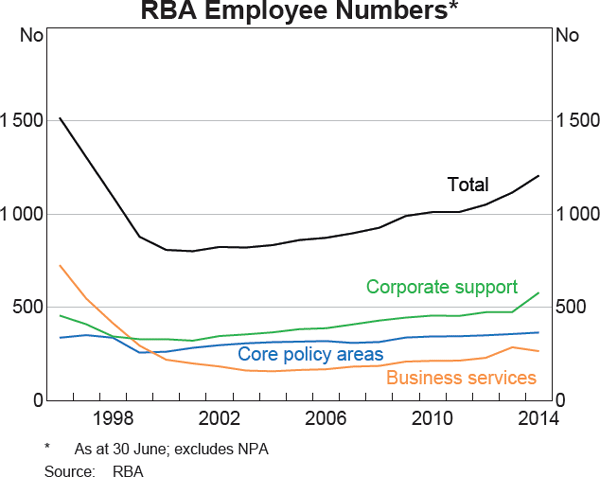
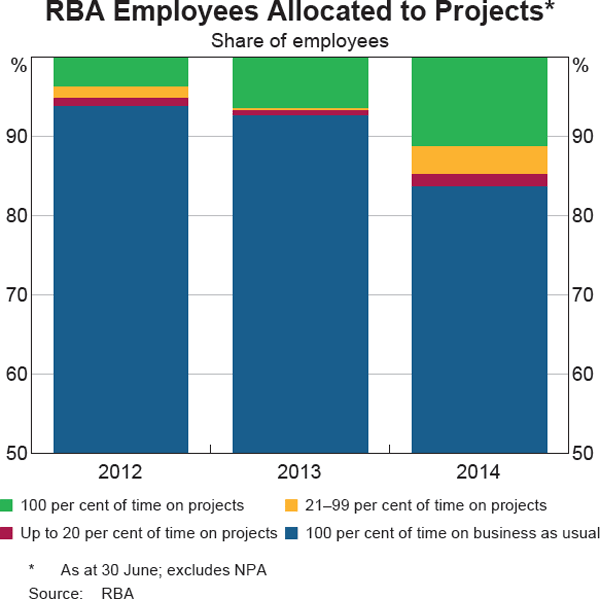
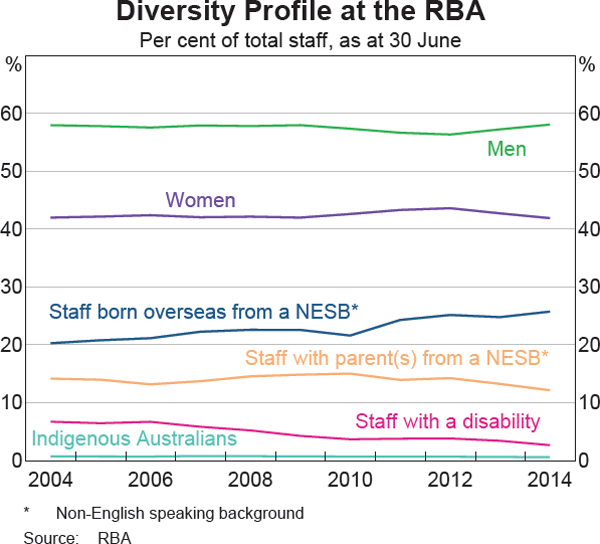
The Reserve Bank reviews its workforce diversity profile each year and reports on developments in its Equity & Diversity Annual Report. Over the past decade, within a relatively stable diversity profile in the Bank overall, there has been an increase in the share of employees from a non-English speaking background and a decline in the share of employees with a disability.
Over 2013/14, the Reserve Bank recruited 214 new staff members, in part reflecting natural turnover but also as a result of newly created positions. A significant proportion of this recruitment was for IT professionals, who accounted for just under half of all new hires. An important recruitment channel for the Bank continues to be the graduate and cadetship programs. In the year to June 2014, the Bank hired 31 graduates and 22 cadets (students in their final year of study who undertake vacation work at the Bank), representing one-quarter of all new employees. These employees work in the Bank's policy, business and corporate service areas and hold degrees in economics, finance, accounting, law, science and other relevant disciplines.
People and culture
The Reserve Bank needs high-quality people working productively together to be able to fulfil its responsibilities. To support this, in 2013 the Bank developed a multi-year strategy for People and Culture. The key objectives of the People and Culture strategy are to:
- identify aspects of the Bank's culture and work environment that are our strengths, as well as areas in which we need to improve, and measure our progress in making improvements
- develop a deep and diverse pool of well-trained potential leaders
- fully utilise the talents of our people
- foster an inclusive and flexible work environment.
Progress was made during the year in meeting these objectives. To support the first objective, all employees were invited to participate in an employee engagement survey. The survey showed that employees are reporting a high level of engagement and also highlighted some potential opportunities to enhance this engagement. Employees across the Reserve Bank have contributed to the development of departmental and enterprise-wide action plans. A follow-up survey will be conducted in around two years to assess progress and identify new opportunities.
The People and Culture strategy also places emphasis on ensuring that the talents of employees are being utilised and the Reserve Bank has a deep and diverse pool of well-trained potential leaders. Accordingly, the Bank has in place a range of development opportunities for employees. While on-the-job training is an important component of this, it is supplemented by formal training programs, such as:
- a two-year Graduate Development Program, consisting of a range of tailored training programs to develop effective business writing, critical thinking, presentation and communication and negotiation skills. A total of 45 graduates are in this program for 2014/15
- programs supporting technical and professional development, including training in project management and change management
- training in management and leadership skills, as well as other general competencies, such as communication skills
- training in the Bank's compliance obligations, including in relation to work health and safety, fraud awareness and anti-money laundering and counter-terrorism financing.
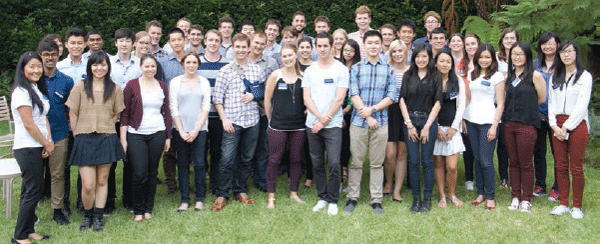
For a limited number of employees there has also been on-the-job training through attachments to other organisations, including the Departments of the Treasury and the Prime Minister and Cabinet, International Monetary Fund, Organisation for Economic Co-operation and Development, Bank of England and Federal Reserve Bank of New York. At the same time, the Reserve Bank has hosted secondees from the Departments of the Treasury and the Prime Minister and Cabinet and the Australian Competition and Consumer Commission.
Financial support was provided to current employees for part-time study in disciplines related to their work, with around 74 employees studying part-time. In addition, the Reserve Bank provides support for full-time postgraduate study at universities in Australia and overseas; in December 2013, three employees were awarded such assistance. Employees who are supported for full-time study are required to reimburse these costs if they resign either while studying or before completing an agreed period of work after returning from study.
The ongoing development of leadership capabilities at the Reserve Bank was a focus during 2013/14. Key work in this area related to better identifying the competencies required for success in leadership positions and making changes to the way in which the performance of senior staff is assessed. The Bank also implemented an annual multi-rater feedback process for senior staff to help identify any development needs and provide additional input into the assessments of performance. New elements were also introduced to the Bank's leadership development programs.
As part of its People and Culture strategy, the Reserve Bank is committed to achieving an inclusive work environment, including greater representation of women in management positions. Women currently hold 31 per cent of managerial positions, up from 24 per cent a decade ago. While the ongoing development of leadership capabilities (as noted above) should assist women to advance to managerial roles, the Bank will continue to explore additional initiatives that would assist with further progress.
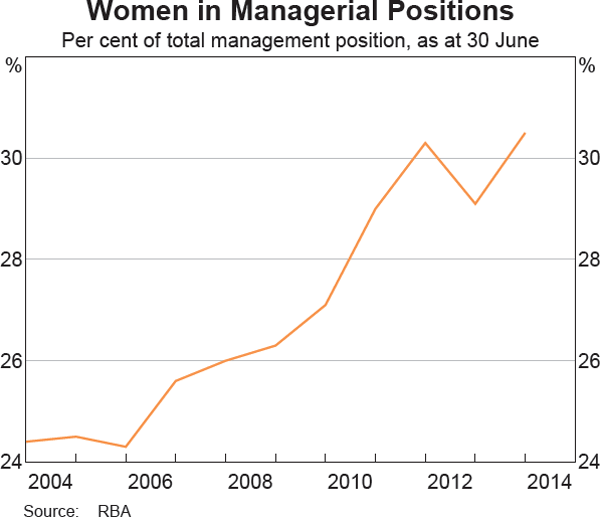
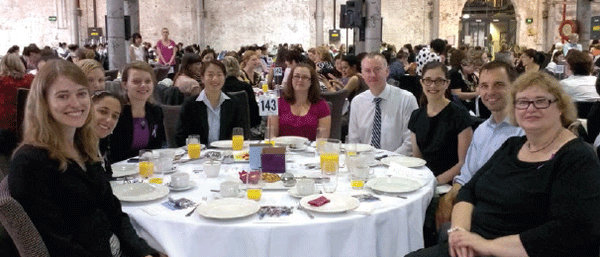
Values and ethics
The Reserve Bank's requirements for its staff and others who are involved in its activities are outlined in the Bank's Code of Conduct, the current version of which was launched in late 2012. The Code sets out the Bank's values, as follows:
- Promotion of the public interest. We serve the public interest. We ensure that our efforts are directed to this objective, and not to serving our own interests or the interests of any other person or group.
- Integrity. We are honest in our dealings with others within and outside the Bank. We are open and clear in our dealings with our colleagues. We take appropriate action if we are aware of others who are not acting properly.
- Excellence. We strive for technical and professional excellence.
- Intelligent inquiry. We think carefully about the work we do and how we undertake it. We encourage debate, ask questions and speak up when we have concerns.
- Respect. We treat each other with respect and courtesy. We value each other's views and contributions.
During 2013/14, the Bank provided employees with training opportunities to support the requirements of the Code and its values, including training in ethical and fraud awareness.
Remuneration
The Reserve Bank strives to offer a total remuneration package that attracts and engages high-calibre employees. During 2013/14, a review of the employee superannuation arrangements was undertaken and as a result, from 1 August 2014, the defined benefit superannuation scheme was closed to new employees and replaced with a defined contribution scheme more in keeping with current practices in both the private and public sectors.
The Reserve Bank's Workplace Agreement provided for a 4 per cent increase in salaries in 2013/14 for the employees it covers, with scope for a modest additional lump sum payment in recognition of good performance. Employees on individual contracts received, on average, a salary increase comparable to that provided by the Workplace Agreement. The Bank will commence discussions with the Finance Sector Union regarding a new workplace agreement in 2014.
Facilities
The Reserve Bank owns premises in locations where there is a business need to do so, including its Head Office in Sydney; the HC Coombs Centre for Financial Studies in Kirribilli, Sydney; office buildings in Melbourne and Canberra; the note printing facility at Craigieburn, north of Melbourne; and the Business Resumption Site in outer Sydney. In addition to the buildings it owns, the Bank leases accommodation for its State Offices in Adelaide, Brisbane and Perth – where its requirements for space are modest – and for its offices in London, New York and Beijing.
The value of the Reserve Bank's property assets increased by almost $8 million to about $333 million in 2013/14, primarily because of an increase in the value of the Melbourne and Kirribilli facilities. A residential property at Kirribilli was sold for $5.2 million in June 2014. Surplus accommodation in the Bank's properties is leased to external tenants. Gross income from these leases in 2013/14 amounted to $10.1 million.
During the year in review, the Reserve Bank continued to strengthen the resilience of facilities supporting critical operations. In Sydney, infrastructure associated with the data centre chilled-water system was upgraded to provide greater reliability and capacity. At Craigieburn, work continued to replace and upgrade the mechanical infrastructure supporting the facility's air conditioning and heating system.
Other work in 2013/14 addressed life-cycle replacements or the refurbishment of accommodation in response to changing business needs. At Head Office, work in the basements provided more accessible and more efficient storage areas and better amenities. Some office accommodation was refurbished and a more efficient and lower-cost domestic water heating system was installed in Head Office. Planning is well under way for the National Banknote Site, which, as noted above and in the chapter on ‘Banknotes’, will entail the construction, on surplus land the Bank owns at Craigieburn, of a new facility for the storage, distribution and processing of banknotes as part of the Next Generation Banknote project.
Environmental Management
The Reserve Bank is committed to improving the environmental performance of its operations. The Environmental Management Committee (EMC) in the facilities management function of the Bank has developed policies that are in accordance with the principles of ecologically sustainable development as set out in the Environment Protection and Biodiversity Conservation Act 1999. These policies reduce the impact of the Bank's operations on the environment and include the following initiatives:
- reducing energy, water and paper consumption
- procuring 10 per cent of electricity needs from renewable (green) sources
- increasing the recycling of paper, co-mingled waste and printing cartridges
- adopting environmentally sustainable designs for office fit-outs
- use of 50/50 recycled paper
- greater use of fuel-efficient vehicles.
Electricity consumption declined by 3 per cent in 2013/14, compared with the five-year average. The biggest reduction in electricity consumption occurred at Craigieburn, which was associated with lower levels of production activity at Note Printing Australia Limited.
Gas consumption during 2013/14 was 5 per cent lower than the average for the previous five years, mainly reflecting the new gas heaters for hot water at Head Office. Use of water fell by 12 per cent, as a result of improved metering arrangements, and was 16 per cent lower than the average of the previous five years.
The amount of waste produced by the Reserve Bank fell by 6 per cent compared with the five-year average.
The Reserve Bank's EMC will continue to set targets and pursue lower energy and water consumption. Some of the initiatives being investigated currently include extending sub-metering systems and seeking greater energy efficiency in IT operations.
Consultancies
The Reserve Bank employs outside contractors and professional service providers to carry out specific tasks where necessary and also, from time to time, uses consultants. Consultants are engaged where the Bank lacks specialist expertise or when independent research, review or assessment is required. Consultants are typically engaged to investigate or diagnose a defined issue or problem; carry out defined reviews or evaluations; or provide independent advice or information to assist in the Bank's decision-making. Prior to engaging consultants, the Bank takes into account the skills and resources required for the task, the skills available internally and the cost-effectiveness of engaging external expertise.
| 2007/08 | 260,000 |
|---|---|
| 2008/09 | 63,000 |
| 2009/10 | 61,000 |
| 2010/11 | 102,000 |
| 2011/12 | 535,000 |
| 2012/13 | 1,190,000 |
| 2013/14 | 387,000 |
|
(a) Sum of individual consultancies that cost $10,000 or more Source: RBA |
|
Spending on consultancies over the past seven years is shown in the table above.
As in previous years, consultancies during 2013/14 covered a range of activities, including corporate governance, risk management and the Bank's operations, with spending again significantly boosted by ongoing work on several major projects.